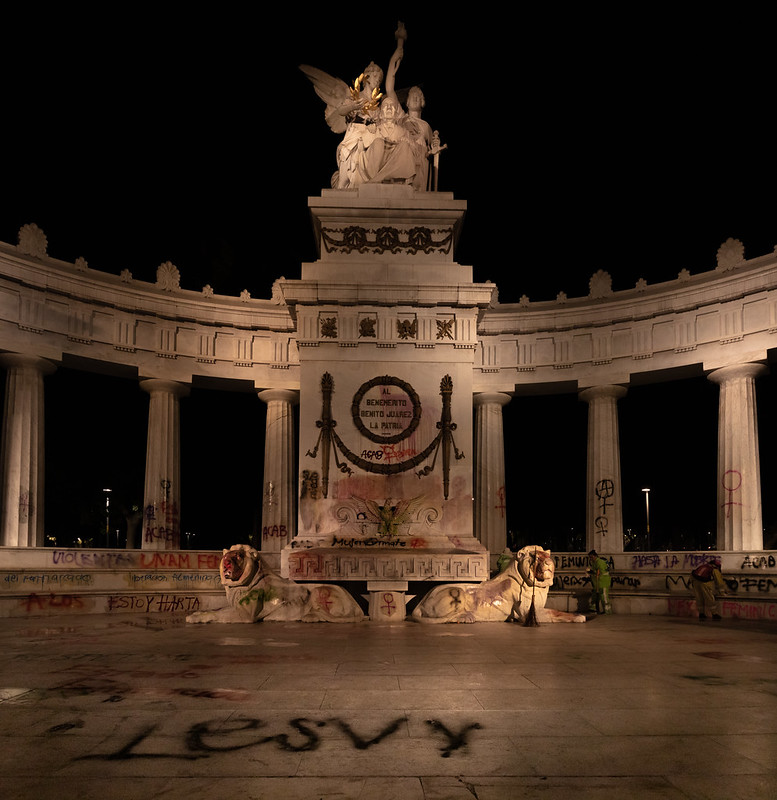International Women’s Day Protests in Mexico Posted by sasha on Mar 10, 2021 in Uncategorized
El 8 de marzo es el Día Internacional de la Mujer (March 8 is International Women’s Day). In the Spanish-speaking world, it’s often referenced as “8-M” for 8 de marzo. Esta fecha no es una celebración festiva, pero es un día para visualizar la desigualdad de género (This date is not a festive celebration, but it is a day to visualize gender inequality). Unfortunately, it’s not an official holiday in any Spanish-speaking countries yet, but it is a non-official holiday in Chile. Este año hubo protestas en la Ciudad de México (This year there were protests in Mexico City). I’ll explain what happened and why in this post about the International Women’s Day protests in Mexico.
A Recent History Lesson
There have been several demonstrations and protests regarding women’s rights in Mexico City in recent years. Last year, a group of female protestors took over the National Human Rights Commission building seeking justice for the vast amount of sexual assault and femicide cases that have gone unpunished. Around 90% of crimes in Mexico go unresolved, and that number has gotten even worse during the pandemic.
The protestors renamed the building, located on Cuba Street, Okupa Cuba Casa Refugio (Cuba Occupation-Shelter House). Inside the building, they painted a mural reading “Ni perdonamos, ni olvidamos” (we neither forgive nor forget). The group goes by the name Bloque Negro (Black Block) and they released a 14-point document listing their demands. You can read it on their Facebook page by clicking here.
They did this in partnership with a feminist organization called Ni Una Menos (Not One (Woman) Less). The name comes from a phrase used by the Mexican activist and poet Susana Chávez, who said “Ni una muerta más” (not one more (woman) dead) in protests to the femicides in the northern city of Ciudad Juárez. Tragically, Chávez was murdered in that very city in 2011. Another rallying cry of the protestors has been “fuimos todas” (it was all of us).
The protestors are also commonly known as las mujeres encapuchadas (the hooded women) as many dress in all black and cover their faces. They’ve become an important symbol in el movimiento feminista (the feminist movement). Protestors taking extreme measures such as breaking windows and defacing property have been common in the capital for years, but large groups of women taking such action are a relatively new sight here. During the protests last year, they spray-painted the phrase Mexico Feminicida (femicidal Mexico) on el Ángel de la Independencia (the Angel of Independence), an iconic symbol of the country.
Around 80,000 people, a vast majority of them women, participated in the March 8th protests in 2020. The day after, tens of thousands of women across Mexico stayed home from work to protest the ongoing violence. It was called un día sin mujeres (a day without women) and it was recognized all over Latin America. Learn more about it in this news clip:
Later in the year, there was another massive protest in the capital – this one demanding legalized abortion in the country.
2021 Demonstrations in CDMX
Around noon on March 8th, a crowd gathered at the emblematic Monumento a la Revolución (the Monument to the Revolution) in the capital. From there, they marched towards the city’s central Zócalo. Along the way, they chanted “Luchar hoy para no morir mañana” (we fight today so we don’t die tomorrow). The Zócalo is home to el Palacio Nacional (the National Palace), which is the residency of current Mexican president Andrés Manuel López Obrador.
The president was a focal point for this year’s protests, as he has come under fire for supporting a politician who has been accused of sexual assault and rape by multiple women. The politician, Félix Salgado Macedonio, is running for governor in the state of Guerrero. When pressed by reporters about his support of Mr. Salgado, AMLO shouted back “Ya chole!” (That’s enough!). He has continued to voice his support for Mr. Salgado despite a rift within his Morena party.
While he campaigned on lifting up marginalized populations in Mexico, including women, many critics say AMLO has failed to protect half of the population as violence against women continues to be a huge problem in Mexico. Many also voiced their criticism at his administration for building a wall around the palace, which appears to many as a walking contradiction to his campaign promises.
Last week, authorities erected metal barricades around the National Palace. Protestors soon began painting the names of hundreds of victims of femicide on said barricades. At least 939 women were victims of femicide in 2020 in Mexico, according to government figures. The think tank Mexico Evalua reported that an astounding 5 million women were victims of sexual violence in the 2nd half of 2020 alone.
During clashes with police on March 8th, some of the barricades were destroyed. They also projected lights on the building’s facade with messages such as “Un violador no será gobernador” (a rapist will not be governor). Police responded by spraying fire extinguishers at the crowd.
Protests were smaller this year, most likely due to concerns about the ongoing pandemic. One thing’s for sure, though – the feminist movement isn’t going anywhere in Mexico and their voices will be heard. Here’s a short news clip about the protests this week from Reuters that shows what the scene in the Zocalo looked like:

Build vocabulary, practice pronunciation, and more with Transparent Language Online. Available anytime, anywhere, on any device.




